Hundreds of IBEW members could be working as early as next spring on construction of the New Jersey Wind Port, a massive project that has union leaders hopeful about the potential for decades of long-term renewable energy jobs for members of the IBEW and other union trades.
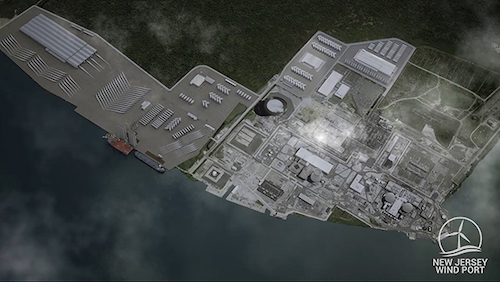
|
| An artist’s conception of the New Jersey Wind Port, planned for construction next to the Hope Creek nuclear power plant in Lower Alloways Township, N.J. Credit: New Jersey Wind Port
|
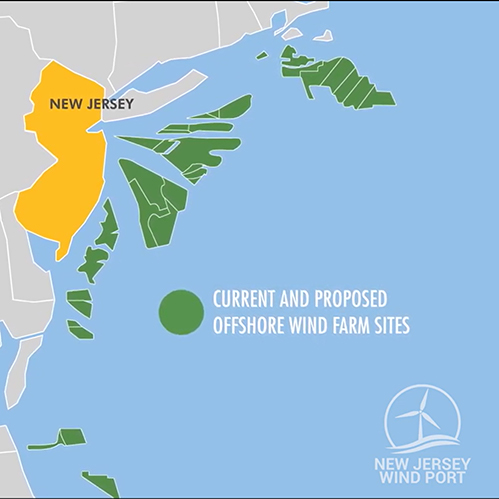
|
When complete, the New Jersey Wind Port will support planned offshore generation projects from Maine to Southern Virginia.
Credit: New Jersey Wind Port
|
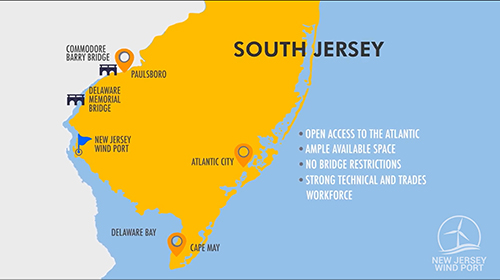
|
The wind port’s proposed location was chosen in part because of its unobstructed access to the Atlantic along with other advantages.
Credit: New Jersey Wind Port
|
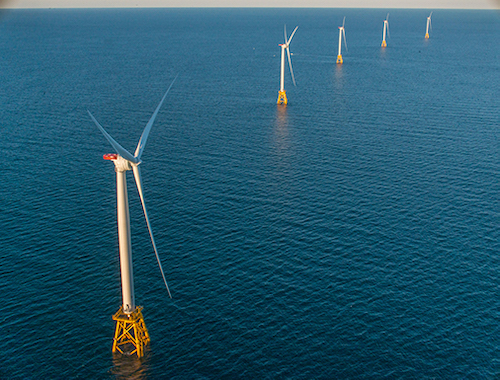
|
| Providence, R.I., Local 99 members helped build the U.S.’s first — and, so far, only — offshore utility-scale wind farm on Block Island, about 13 miles off Rhode Island’s shore.
|
“This project announcement could not have come at a better time considering the uncertainty of future construction due to COVID-19,” said Folsom, N.J., Local 351 Business Manager Dan Cosner, whose South Jersey jurisdiction covers the wind port’s planned Salem County location at the mouth of the Delaware River.
In June, Garden State Gov. Phil Murphy announced plans for the 200-acre, $400 million production and assembly facility to be built in Lower Alloways Creek, where he believes it will serve as a major first step toward making his state a nerve center for the offshore wind projects slated for construction along the U.S. Atlantic Coast over the next decade.
“Wind generation discussions in New Jersey have been going on for 10 to 15 years,” Cosner said. “Gov. Murphy has been pushing green energy a long time, and he jumpstarted the talks over the last three or four years to make it a reality here.”
Right now, almost all utility-scale wind power generation in the U.S. and Canada is land-based, supplementing traditional and reliable baseload power sources such as nuclear and coal. But Murphy hopes the wind port will reveal the potential of off-shore wind and help New Jersey dominate the wind energy field — much like oil made Texas king of that industry in the last century.
“Somebody’s going to get to be the Houston of American offshore wind,” quipped Tim Sullivan, chief executive of the New Jersey Economic Development Authority, in an interview with The Washington Post.
When the wind port’s initial work is complete, the facility will support at least nine offshore generation projects planned by Denmark-based Orsted. “They’re the guys, the movers and shakers,” Cosner said.
The IBEW has worked with Orsted before. Providence, R.I., Local 99 members were instrumental in getting the company to build the U.S.’s first — and, so far, only — offshore utility-scale wind farm on Block Island, about 13 miles off Rhode Island’s shore. The project’s five turbines became operational in 2016.
“Future offshore wind farm projects can leverage what the IBEW learned in Rhode Island and expand on it,” said Third District International Vice President Mike Welsh.
One such project is Ocean Wind, a partnership between Orsted and Public Service Electric and Gas, a utility that employs thousands of IBEW members in New Jersey and New York. Ocean Wind will be New Jersey’s first utility-scale offshore wind farm by installing seven massive General Electric turbines about 15 miles off the coast of southern New Jersey by 2024.
The eight offshore projects in addition to Ocean Wind, from Maine to Southern Virginia, either have been set in motion or remain in development. “We’re curious to see how it’s all going to work out, but it could be a great opportunity for the IBEW,” Welsh said.
But before any massive and majestic wind turbines can get placed, IBEW members will be fully involved in Phase 1 of the wind port project, wiring new buildings for office and engineering staff and turbine assembly and staging.
Alloways Creek is the perfect place, Cosner said, because it’s miles from any residential site. The new port will abut the Hope Creek nuclear power plant, most of whose PSE&G workers are represented by Cranbury, N.J., Local 94.
Typically, offshore wind turbines are manufactured and assembled overseas and then get shipped standing vertically on specially designed cargo vessels.
But for Ocean Wind, Orsted plans to ship the overseas-built GE turbine parts to Alloways Creek for assembly. At 853 feet, they will be among the tallest turbines ever built, and as the wind port’s location sits about 50 miles downriver of Philadelphia, the turbines will have an open, obstruction-free ride out to their emplacements along the mid-Atlantic coast. Its central location gives the facility unique advantages over any other location in the U.S., according to planners at the New Jersey Economic Development Authority.
Under Phase 2, New Jersey hopes to see the wind port become a full-fledged manufacturing center for turbine parts. “We’d like to get the work on building them entirely here, too,” said Third District International Representative Wyatt Earp.
“We’re trying now to show Orsted that it would be cheaper and more efficient to do that in the U.S.,” Cosner said. Doing so would bring millions of investment dollars across the state and create high-quality manufacturing and construction jobs for IBEW members.
There are potentially hundreds more electrical jobs that could come out of work in the switching yards where power from the turbines would come ashore, Earp said.
“Other trades are naturally trying to get their foot in the door, too,” said Cosner, who is also president of the Southern New Jersey Building Trades Council. “Of course, we’re going to keep trying to capture all of the electrical work.”
Figuring out the various jurisdictions will be a balancing act, said New Brunswick, N.J., Local 456 Business Manager Joseph Egan. “Transmitting power would come under Local 456 because our linemen do all that work,” he said. “But we’ll keep talking to the other trades and keeping the lines of communication open.”
Egan and Cosner are confident that the union can acquire the future turbine and cable installation work as well.
“We told Orsted we want to get ahead of this, so let us start getting the training we need now,” Cosner said. “And if it means our folks will have to live on boats for weeks at a time, we’re willing to do that, too.”
“We’re constantly asking the question: ‘What do you need?’” Earp added. “Taxpayers and ratepayers are spending a lot of money on this, so we want to give them the best value for the best return.” Murphy estimates that the wind port could cost between $300 million and $400 million to build, with PSE&G splitting the bill.
“We have a great relationship with Gov. Murphy,” Cosner said. IBEW members and locals were among his earliest and most visible backers for office, and he has long returned that confidence with strong public support for Labor and workers’ issues. “He advocated from Day 1, pushing for all this wind port work to be done by union workers.”
Even so, ensuring the port jobs went to the IBEW and other union members “took a lot of work,” said Earp, who also serves as political and legislative coordinator for the state. “[Political and Legislative Affairs Director] Austin [Keyser] and his staff spent a lot of time with us getting the state board of public utilities and other agencies involved and on board,” he said.
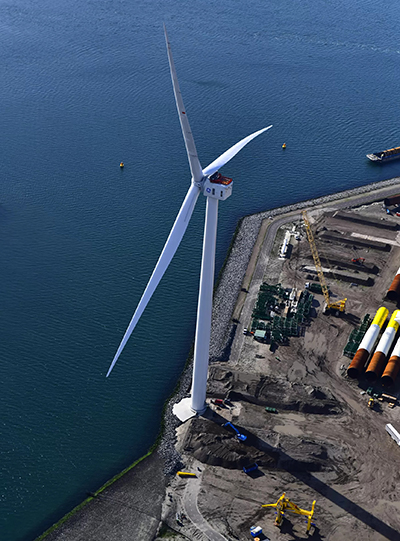
|
Seven turbines like this massive GE Haliade prototype are set to be installed off the New Jersey coast, work that the IBEW is pressing hard to capture.
Credit: GE Renewable Energy
|
Murphy’s commitment to using union labor for the wind port includes an emphasis on bringing in a significant number of minority and women workers. Last December, the South Jersey building trades council signed a memorandum of understanding with Orsted insisting on a project labor agreement and payment of a prevailing wage.
But the talking and the lobbying must continue, Earp said. “While this is a great opportunity for us, what we can’t forget is that we can never stop just because we think we’ve already arrived,” he said.
It helps, he said, that four IBEW members serve in New Jersey’s Legislature. In the General Assembly, Egan represents District 17 and is a deputy majority leader and chairman of the labor committee. Trenton Local 269 President and Assistant Business Manager Wayne DeAngelo represents District 14 and is a deputy speaker. And Asbury Park Local 400 member Eric Houghtaling represents District 11 and serves as a deputy majority leader as well. In the Senate, Local 400 member Vin Gopal represents District 11 and serves as the majority conference leader.
The wind port enjoys support from Washington as well, where Local 351 member Donald Norcross, a former business agent, has represented New Jersey’s First Congressional District in the U.S. House of Representatives since 2014.
“As an electrician, I know we need to make sure our local workers can take full advantage of America’s transfer to energy-efficient technology, and as a member of Congress, I’m working hard to modernize our infrastructure and invest in America’s health and security,” Norcross said. “The New Jersey Wind Port checks all those boxes. The future of clean energy will be built right here in South Jersey, powering our economy and creating jobs for highly-skilled workers throughout the region.”
With COVID-19 still raging and uncertainty surrounding the U.S. economy Welsh pledged to keep working to make the project a reality. “There are a lot of unknowns, so we’ll keep dealing with the knowns and working from there,” he said.
But New Jersey’s investment in off-shore wind and other energy-generation sources and Murphy’s commitment to union labor is still encouraging, said International President Lonnie R. Stephenson.
“As renewable energy continues to grow across North America, especially as we face the reality of climate change, the wind port represents a real growth opportunity for the IBEW,” he said. “It’s fitting that this project is being developed literally in the shadow of Hope Creek’s cooling tower, because it’s going to take a mix of zero-carbon energy like nuclear, wind and solar to truly reduce carbon emissions in the U.S.
“We’re eager to capture as much of that work as possible in ways that preserve quality middle-class jobs and protect our overall energy future,” Stephenson said.